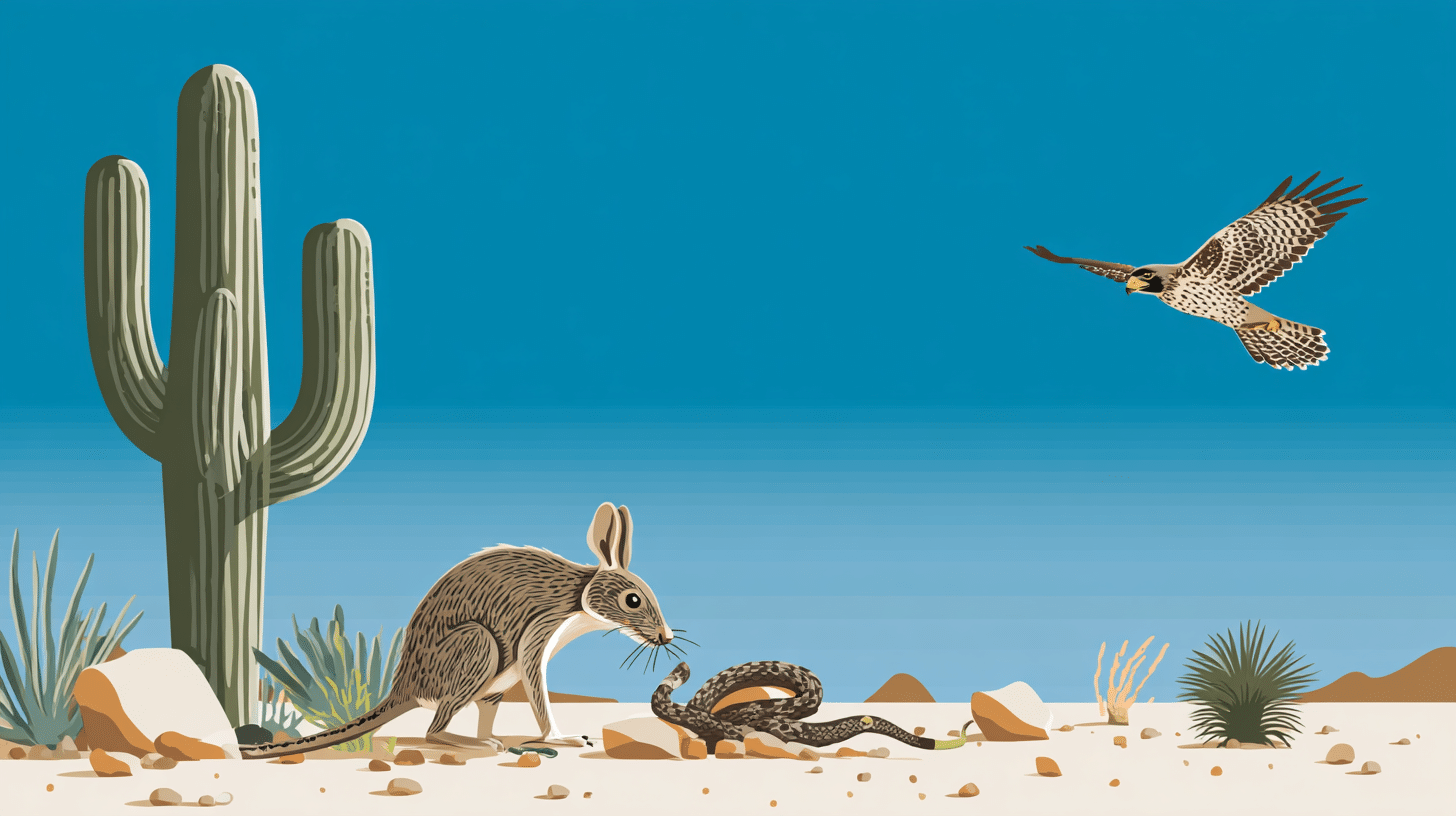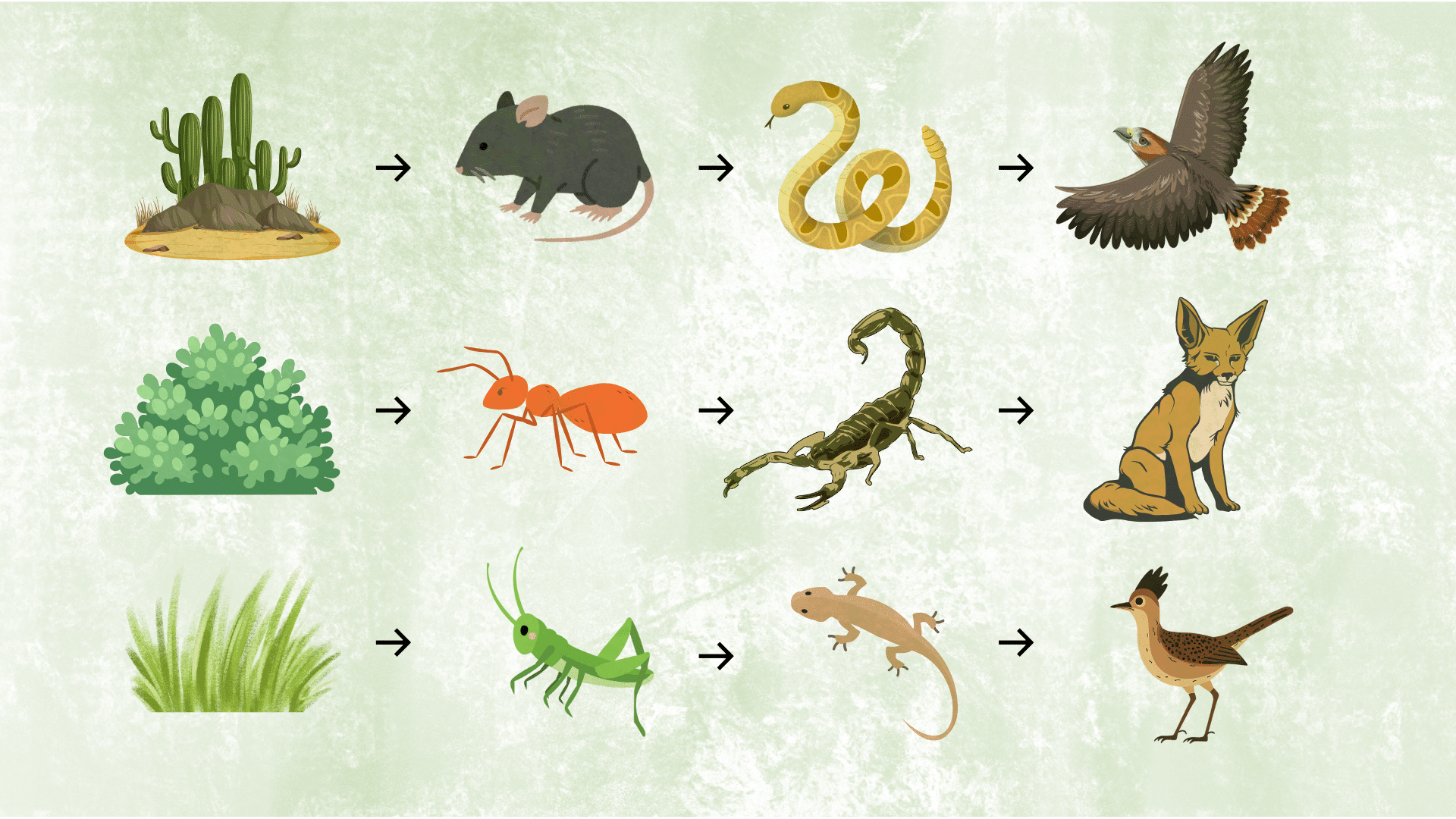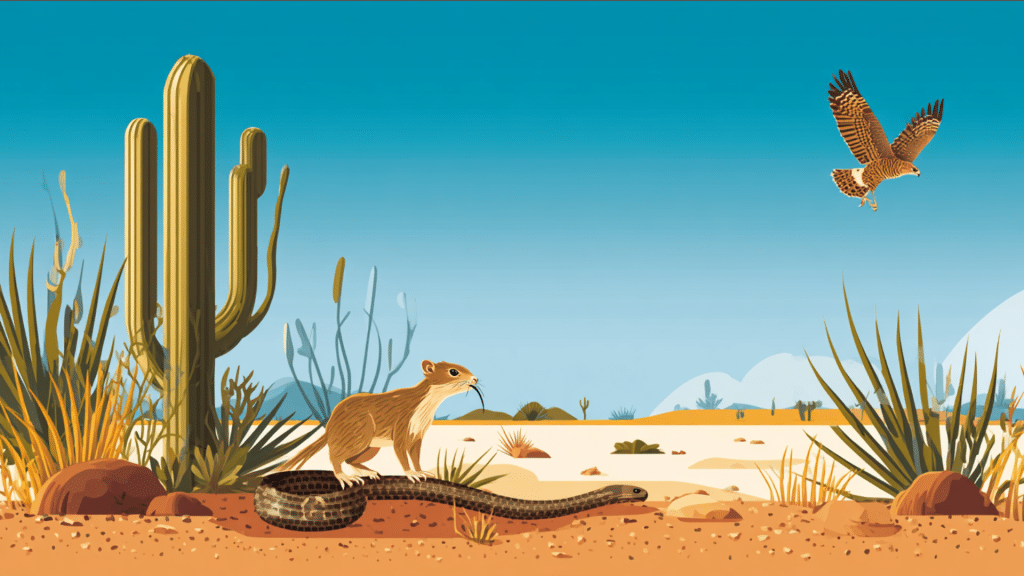When I think about life in the desert, I’m amazed at how plants, animals, and even people survive in such tough conditions. A desert food chain shows the link between them, from tiny producers to powerful predators.
In this blog, I’ll explain what a food chain is and highlight the key parts that keep it running.
You’ll see clear examples, learn the difference between food chains and food webs, and how they vary across deserts like the Sahara, Sonoran, Mojave, and Gobi.
I’ll also share the role humans play, the challenges caused by climate change, habitat loss, and invasive species, plus answer common questions many people still have.
What is a Desert Food Chain?
A desert food chain shows how plants and animals get energy and pass it on to others. It’s a step-by-step path of “who eats whom” in the desert.
It always starts with plants. Then, small animals eat those plants. Bigger animals eat the smaller ones. Finally, top predators keep the balance of the ecosystem.
Example Diagram

- Cactus (producer) → makes its own food from sunlight
- Kangaroo rat (primary consumer) → eats the cactus
- Rattlesnake (secondary consumer) → eats the rat
- Hawk (tertiary consumer) → eats the rattlesnake
This simple chain shows how energy moves through the desert, keeping life connected.
Key Components of the Desert Food Chain
Every desert food chain has a few main parts. Each group plays an important role in moving energy through the ecosystem.
1. Producers
These are plants that make their own food using sunlight.
- Cacti
- Shrubs
- Grasses
2. Primary Consumers
These are herbivores that eat plants.
- Rodents like kangaroo rats
- Insects such as ants and grasshoppers
- Other small plant-eating animals
- Secondary Consumers
These animals eat the primary consumers.
- Reptiles like lizards and snakes
- Scorpions
- Small carnivores
3. Tertiary Consumers
These are top predators that eat secondary consumers.
- Hawks
- Foxes
- Coyotes
4. Decomposers
These break down dead plants and animals, putting nutrients back into the soil.
- Fungi
- Bacteria
- Some insects
Each group depends on the others, keeping the desert ecosystem balanced and alive.
Examples of Desert Food Chains

A desert food chain depends on limited plants and animals, making every connection vital for survival. Plants store water and energy, small animals feed on them, and predators rely on those smaller creatures.
Simple examples show how energy flows step by step and how each species depends on the other in a harsh environment.
Example 1
Cactus → Rat → Rattlesnake → Hawk
- The cactus stores water and food.
- The rat eats parts of the cactus.
- The rattlesnake hunts the rat.
- The hawk swoops down to eat the rattlesnake.
Example 2
Shrub → Ant → Scorpion → Fennec Fox
- The shrub provides food for ants.
- Ants are eaten by scorpions.
- The scorpion becomes prey for the fennec fox.
Example 3
Grass → Grasshopper → Lizard → Roadrunner
- Grass feeds the grasshopper.
- The lizard feeds on the grasshopper.
- The roadrunner catches and eats the lizard.
These examples show that a desert food web is made up of many smaller chains like these. Together, they create a strong and connected system that supports life in harsh desert conditions.
Food Chains vs. Food Webs
| Aspect | Desert Food Chain | Desert Food Web |
|---|---|---|
| Definition | A simple path showing how energy moves from plants to animals. | A complex network connecting many food chains together. |
| Structure | Follows one line (e.g., cactus → rat → snake → hawk). | Includes multiple overlapping paths between plants and animals. |
| Feeding Links | Each animal usually eats one type of food. | Most animals eat more than one thing and have more than one predator. |
| Balance | Easier to break since it relies on fewer links. | Stronger and more balanced because of many connections. |
For example, in the Sonoran Desert, many chains overlap:
- Producers: mesquite trees, cacti, and grasses
- Primary consumers: kangaroo rats, ants, grasshoppers
- Secondary consumers: lizards, snakes, scorpions
- Tertiary consumers: coyotes, hawks, bobcats
A diagram of this desert food web would show lines crossing between many plants and animals. This shows how life in the desert is closely linked, with every species playing a role in survival.
Regional Desert Food Chains
Each desert has its own mix of plants, animals, and conditions, so food chains vary. Water, soil, and climate shape what can survive.
1. Sahara Desert
- Producers: sparse grasses and small shrubs
- Primary consumers: camels, rodents
- Secondary consumers: snakes and lizards
- Tertiary consumers: desert foxes, humans
2. Sonoran Desert
- Producers: mesquite trees, cacti, grasses
- Primary consumers: kangaroo rats, insects
- Secondary consumers: snakes, scorpions
- Tertiary consumers: coyotes, hawks
3. Mojave Desert
- Producers: Joshua trees, cacti
- Primary consumers: insects, rodents
- Secondary consumers: snakes, lizards
- Tertiary consumers: owls, bobcats
4. Gobi Desert
- Producers: very limited due to the harsh climate
- Primary consumers: hardy rodents and insects
- Secondary consumers: reptiles and small carnivores
- Tertiary consumers: wolves, large birds of prey
These regional food chains show how each desert ecosystem adapts to its climate and resources, but they all follow the same basic pattern of energy flow.
Role of Humans in the Desert Food Chain
Humans are also part of the desert food chain, and what we do can change how life in the desert works.
A long time ago, people in deserts used plants and animals carefully. They picked fruits, hunted small animals, and only took what they needed, so nature stayed balanced.
Today, people build farms, roads, and cities in deserts. This can take away plants, scare animals, and change which creatures can survive.
Sometimes, humans even act like top predators – taking the place of animals that would normally hunt. This makes the food chain shift and can upset the balance in the desert.
Modern Challenges to Desert Food Chains
Today, desert food chains face new pressures that affect the balance of life. These challenges often start with humans and spread through the whole ecosystem.
- Climate Change Effects: Hotter temperatures and shifting rainfall patterns make it harder for plants to survive. With fewer plants, herbivores struggle to find food, and predators lose their prey.
- Habitat Loss: Cities, roads, and farms take up space that once belonged to desert wildlife. When habitats shrink, food chains break apart and species become more vulnerable.
- Invasive Species: Non-native plants and animals can disrupt desert food webs. They compete with native species, spread quickly, and upset the natural balance of energy flow.
Protecting deserts means addressing these challenges so food chains can continue to support life.
Conclusion
A desert food chain is more than plants and animals eating one another – it’s the balance that keeps life going in some of the toughest places on Earth.
From tiny insects to powerful predators, every connection matters, and when one piece is lost, the whole chain feels the impact.
I believe learning about these links helps us understand how fragile and important deserts really are. With challenges like climate change, habitat loss, and invasive species, protecting desert ecosystems is more important than ever.
By teaching, sharing, and making small changes, we can all help.











